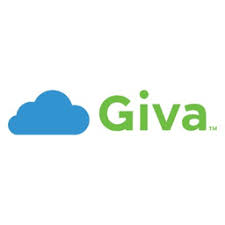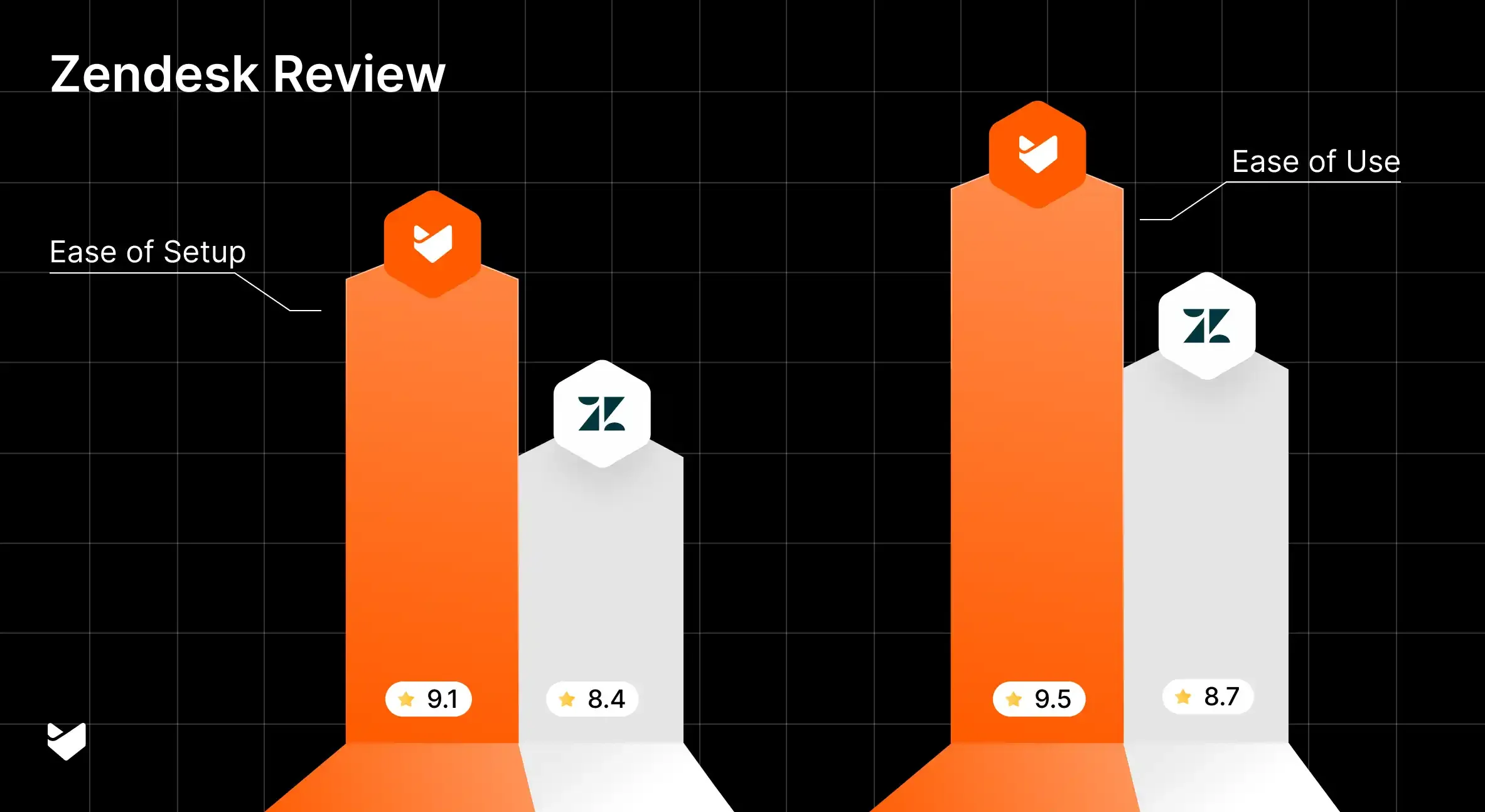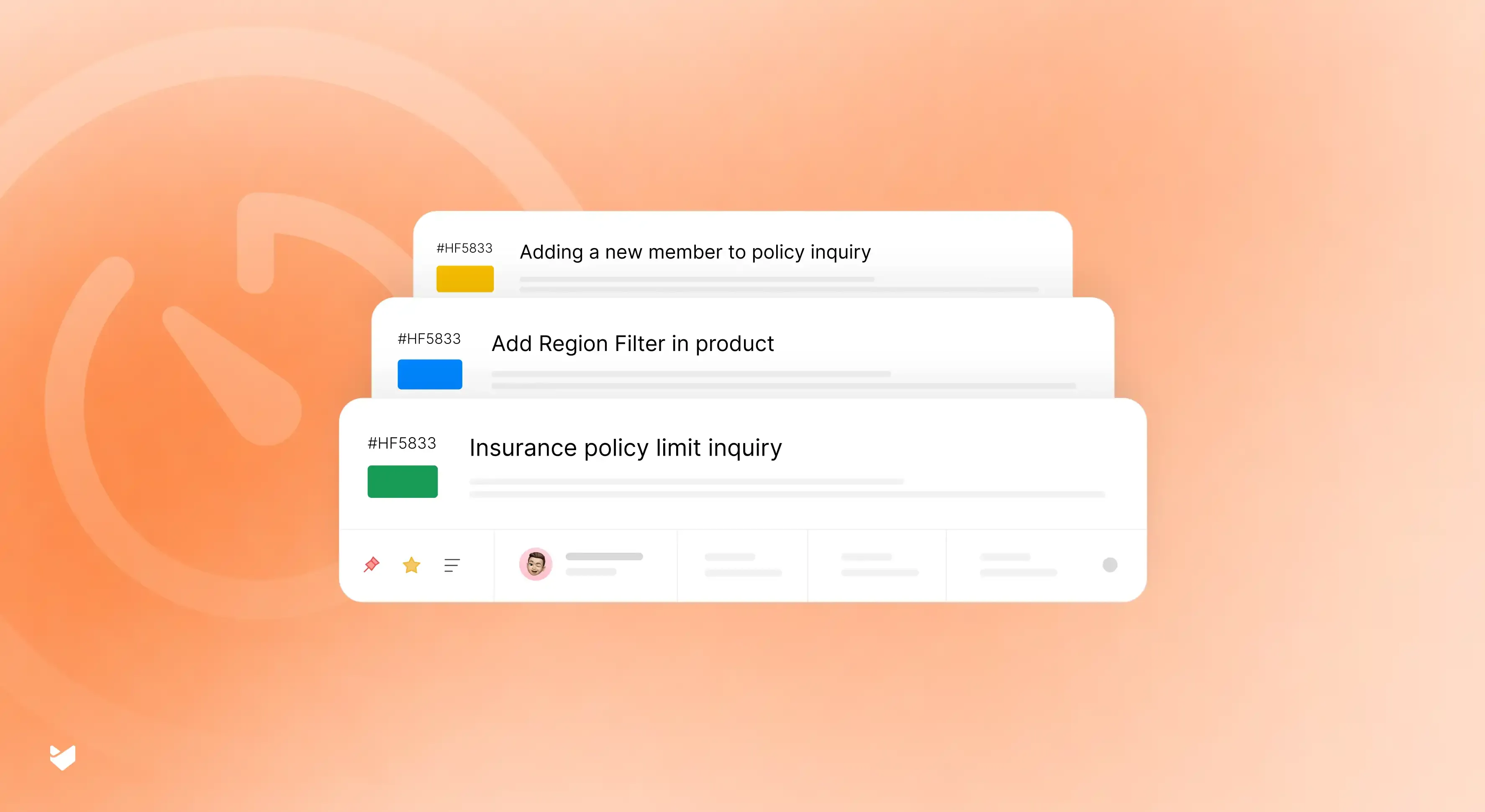Trouble Ticket Management: The Complete Guide for 2025

Shalin
Founder & CEO HappyFox
October 21, 2025
Efficient customer issue management directly impacts business success. Companies that excel at resolving problems retain more customers, reduce support costs, and gain valuable product insights.
Trouble ticket management systems centralize customer communications, converting emails, calls, and messages into organized, trackable tickets. These systems ensure proper routing, prioritization, and resolution tracking while providing metrics to measure performance.
This guide covers the essential elements of trouble ticket management—key features, implementation strategies, best practices, and measurement techniques. You'll find practical information to help select, implement, and optimize a ticket system that fits your organization's needs and improves customer satisfaction.
Trouble ticket management refers to the systematic process of recording, tracking, organizing, prioritizing, and resolving customer support requests or issues through a dedicated system. This approach provides structure to customer interactions, ensuring no request falls through the cracks and every issue receives appropriate attention.
A robust trouble ticket management system serves as the central nervous system of your support operations, capturing all customer communications across multiple channels, routing them to the right team members, and providing the tools needed for efficient resolution.
Implementing a strategic approach to trouble ticket management delivers substantial benefits:
- Enhanced Response Times: Properly categorized and prioritized tickets ensure urgent matters receive immediate attention
- Improved Issue Resolution: Comprehensive ticket tracking leads to faster, more accurate problem solving
- Increased Customer Satisfaction: Streamlined processes result in better customer experiences and higher loyalty
- Team Productivity: Support agents spend less time on administrative tasks and more on solving customer problems
- Valuable Data Collection: Every ticket becomes a source of insights to improve products and services
- Operational Efficiency: Automated workflows reduce manual effort and minimize human error
Top Trouble Ticketing System - A Deep Dive
Key Components of a Trouble Ticket Management System
Modern customers reach out through multiple channels, and an effective trouble ticket management system must consolidate these communications:
- Email Integration: Automatically convert incoming support emails into trackable tickets
- Web Forms: Allow customers to submit detailed requests directly from your website
- Social Media: Capture and respond to mentions and direct messages on platforms like Twitter, Facebook, and Instagram
- Live Chat: Transform real-time conversations into tickets when complex issues require follow-up
- Phone Support: Create tickets from voice interactions to maintain a complete customer history
- Mobile Apps: Enable ticket creation through your company's mobile application
Learn More: The 7 Best Customer Service Channels (& How to Pick Them)
Once created, tickets must be properly categorized and directed to the right personnel:
- Automatic Categorization: Apply tags based on content analysis to sort tickets by department, product, or issue type
- Priority Assignment: Determine issue urgency based on predefined criteria or AI analysis
- Intelligent Routing: Direct tickets to the most qualified agents based on expertise, workload, and availability
- SLA Management: Automatically flag tickets approaching breach of service level agreements
Streamline repetitive processes to maximize efficiency:
- Predefined Response Templates: Quick access to approved messaging for common inquiries
- Automated Status Updates: Keep customers informed of progress without manual intervention
- Escalation Rules: Automatically elevate tickets when resolution time exceeds thresholds
- Task Assignment: Break complex issues into manageable tasks assigned to different team members
- Approval Workflows: Establish structured review processes for critical actions
Connect your trouble ticket system with your knowledge resources:
- Article Suggestions: Recommend relevant documentation to agents based on ticket content
- Self-Service Portal: Empower customers to find answers before creating tickets
- Knowledge Capture: Convert successful ticket resolutions into new knowledge base articles
- Feedback Loop: Use ticket data to identify gaps in your knowledge base
Transform ticket data into actionable insights:
- Performance Metrics: Track key indicators like first response time, resolution time, and customer satisfaction
- Trend Analysis: Identify recurring issues that might indicate deeper product or service problems
- Team Performance: Evaluate individual and group productivity and effectiveness
- Customer Insights: Understand customer behavior, preferences, and pain points
Best Practices for Trouble Ticket Management
-
Establish Clear Ticket Categorization:
Develop a consistent taxonomy that allows for precise ticket classification:
- Create categories that reflect your products, services, and common issue types
- Implement a hierarchical structure with main categories and subcategories
- Regularly review and refine categories based on ticket patterns
- Ensure categories are mutually exclusive and collectively exhaustive
-
Define and Enforce SLAs:
Set clear expectations for ticket handling:
- Establish response and resolution timeframes for different ticket priorities
- Create automated alerts for approaching SLA breaches
- Track SLA compliance as a key performance indicator
- Communicate relevant SLA information to customers
-
Implement Effective Escalation Procedures:
Create clear pathways for handling complex or sensitive issues:
- Define specific criteria for when tickets should be escalated
- Establish escalation paths based on issue type and severity
- Ensure proper documentation accompanies escalated tickets
- Build in accountability for escalated ticket resolution
-
Optimize Agent Workflows:
Design processes that maximize agent productivity:
- Organize the agent interface to display the most relevant information first
- Provide one-click access to common actions and responses
- Implement keyboard shortcuts for frequently used functions
- Enable agents to handle similar tickets in batches when appropriate
-
Foster Cross-Department Collaboration:
Break down silos between teams:
- Allow visibility into tickets across departments
- Enable easy handoffs between different support tiers
- Create collaborative spaces for complex problem-solving
- Establish clear ownership rules for shared tickets
-
Maintain a Customer-Centric Approach:
Keep the customer experience at the forefront:
- Personalize communications based on customer history
- Maintain context across multiple interactions
- Provide proactive updates on ticket status
- Collect and act on customer feedback
-
Continuously Improve Based on Data:
Use ticket analytics to drive ongoing optimization:
- Regularly review ticket metrics and trends
- Identify bottlenecks in the resolution process
- Recognize knowledge gaps among support staff
- Refine categories, templates, and workflows
Evaluation Criteria: What to Look for When Selecting a Trouble Ticket System
When researching trouble ticket management solutions, use these evaluation criteria to compare options and select the system that best matches your organization's specific requirements:
-
Usability and Adoption Potential:
Assess how easily your team can learn and effectively use the system:
- Interface Intuitiveness: Does the dashboard present information clearly without overwhelming users?
- Training Requirements: How much time is needed to onboard new agents?
- Accessibility Features: Does the system accommodate users with different abilities?
- Mobile Capabilities: Can agents work effectively from smartphones or tablets?
- Customization Flexibility: Can users adjust their workspace to match their workflow?
-
Channel Coverage and Consolidation:
Evaluate how comprehensively the system captures customer communications:
- Channel Breadth: Does it cover all the ways your customers reach out?
- Integration Depth: How seamlessly does it incorporate messages from different sources?
- Context Preservation: Does it maintain conversation history across channels?
- Unified Interface: Can agents manage all communications from a single workspace?
- Future Channel Adaptability: How easily can new communication channels be added?
-
Automation Sophistication:
Compare the system's ability to reduce manual work through intelligent automation:
- Rule Complexity: Can it handle multi-condition automation scenarios?
- Setup Simplicity: How accessible is automation creation for non-technical users?
- Testing Capabilities: Can automations be tested before deployment?
- Performance Monitoring: Does it track automation effectiveness?
- AI Enhancement: Does the system use machine learning to improve automations over time?
-
Knowledge Management Effectiveness:
Assess how well the system leverages organizational knowledge:
- Findability: How easily can agents locate relevant information?
- Maintenance Tools: What features support keeping content current?
- Contextual Surfacing: Does the system proactively suggest relevant articles?
- Customer Access: How effectively can customers use the knowledge base?
- Content Analytics: Does it track which articles resolve issues most effectively?
-
Reporting Depth and Accessibility:
Evaluate the system's ability to transform data into actionable insights:
- Metric Coverage: Does it track all your essential performance indicators?
- Visualization Options: How effectively does it present complex data?
- Customization Flexibility: Can you create specialized reports for different stakeholders?
- Real-time Capabilities: Does it provide up-to-the-minute performance data?
- Insight Generation: Does it go beyond raw data to suggest improvements?
-
Integration Ecosystem:
Compare how well the system connects with your existing technology stack:
- Pre-built Connectors: Does it offer ready-made integrations with your current tools?
- API Robustness: How comprehensive and well-documented are the APIs?
- Authentication Methods: Does it support your security requirements for connections?
- Data Synchronization: How efficiently does it exchange information with other systems?
- Integration Maintenance: How are integrations updated when either system changes?
-
Customization and Flexibility:
Assess how adaptable the system is to your specific business processes:
- Configuration Scope: What aspects can be customized without coding?
- Development Options: What capabilities exist for custom extensions?
- Upgrade Compatibility: Will customizations break during system updates?
- Business Logic Support: Can it accommodate complex conditional workflows?
- Multi-department Adaptability: Can the system serve different teams with distinct needs?
-
Security and Compliance Alignment:
Evaluate how well the system meets your regulatory and security requirements:
- Certification Status: Does it hold relevant compliance certifications?
- Data Protection: How is sensitive information secured at rest and in transit?
- Access Controls: How granular are the permission settings?
- Audit Capabilities: How comprehensive is the tracking of system activities?
- Compliance Updates: How does the vendor address new regulatory requirements?
-
Scalability and Performance:
Compare how systems will perform as your business grows:
- Load Testing Results: How does the system perform under high volume?
- Scaling Costs: How does pricing change as usage increases?
- Performance History: What is the vendor's track record for reliability?
- Growth Accommodation: Can the system expand without major disruptions?
- Resource Requirements: What infrastructure is needed for optimal performance?
-
Vendor Partnership Potential:
Assess the long-term relationship prospects with the solution provider:
- Support Quality: How responsive and helpful is their customer service?
- Development Roadmap: Does their vision for the product align with your needs?
- Customer Community: Is there an active user base sharing best practices?
- Implementation Assistance: What resources do they provide for onboarding?
- Financial Stability: Is the vendor positioned to provide long-term support?
-
Innovation and Future-Readiness:
Evaluate the system's ability to incorporate emerging technologies:
- AI Implementation: How effectively does it use artificial intelligence for practical benefits?
- Feature Release Cadence: How frequently are new capabilities introduced?
- Emerging Technology Adoption: How quickly does the vendor integrate new innovations?
- Customization vs. Code: Can you extend the system without developers?
- Vision Alignment: Does the product roadmap match future industry trends?
Top Trouble Ticket Management Software Solutions

HappyFox



HappyFox offers a robust trouble ticket management system with features designed to streamline support workflows. The system converts requests from multiple channels into trackable tickets while offering customization options that allow organizations to tailor processes without added complexity. Its automation suite helps reduce repetitive tasks, while the built-in knowledge base facilitates both agent assistance and customer self-service. The platform's reporting tools provide detailed insights into support performance.
Trusted by over 2,000 organizations across 70+ countries, HappyFox is designed for businesses of all sizes, from startups to enterprises. The platform's straightforward setup and minimal learning curve make it accessible for teams without extensive technical resources.
Key Features
-
Smart ticket categorization:
Automatically analyzes ticket content and routes requests to the most qualified agents based on subject matter expertise and current workload distribution.
-
Comprehensive SLA management:
Maintain service commitments with real-time SLA tracking, automated deadline notifications, and escalation workflows that ensure timely ticket resolution.
-
Multi-brand support for complex organizations:
Centrally manage multiple brands under one platform while maintaining distinct customer portals, branding, and customized support processes for each entity.
-
AI-powered insights:
Leverage artificial intelligence to generate ticket summaries, provide response suggestions, and identify knowledge base gaps for continuous improvement.
-
Extensive integration capabilities:
Seamlessly connect with 50+ popular SaaS applications including customer relationship management, project management, accounting, and marketing tools for unified operations.
Key Strengths
-
Intuitive Interface & Rapid Setup:
No steep learning curve or complex onboarding—get your support system running in under an hour with powerful features that don't require extensive training.
-
Customization Flexibility:
Adapts to any team or use case with deep customization across ticketing, support centers, workflows, automations, and reporting—going beyond one-size-fits-all solutions.
-
Comprehensive AI-Powered Support:
AI-driven productivity with instant ticket summaries, smart response suggestions, automatic resolution recommendations, priority detection, and knowledge base optimization.
-
Scalable & Transparent Pricing:
Flexible pricing that grows with your team—start small and scale effortlessly without hidden costs. Plus unlimited-agent plans with cost-saving potential for larger teams.
-
Exceptional Customer Support Culture:
Entire team, including leadership, is committed to your success—ensuring faster escalations, quicker resolutions, and direct access to decision-makers.
-
Enterprise Features Without Complexity:
Get all the functionality you need without unnecessary complexity, steep learning curves, or the overhead typically associated with enterprise solutions.
Ideal For
-
- Startups with limited resources that need quick setup, AI automation, and affordable pricing that scales.
- Growing companies that need simple, all-in-one solutions without complexity or high costs.
- Organizations with multiple teams (IT, HR, Facilities) that need unified collaboration for internal and external support.
- Large operations that need enterprise-grade security, global deployment, and deep system integrations.


HappyFox's intuitive interface and ease of use meant we were operational within hours, not days. The simplicity and efficiency of HappyFox allowed us to transform our service desk operations.
John Stergakis
CIO, SLAM

SolarWinds



SolarWinds specializes in IT service management, offering powerful trouble ticket tracking combined with hardware and software asset management. The system excels at automatically generating tickets from service requests and includes detailed reporting for performance monitoring.
Key Features
-
Automated ticket generation and assignment
-
IT asset tracking and association with tickets
-
Built-in change management capabilities
-
Detailed SLA monitoring and reporting
-
Advanced security and compliance features
Key Strengths
-
IT-focused trouble ticket management, asset management integration, and comprehensive SLA tracking
We also recommend reading:
Best Practices for Implementing a Ticketing System

Zoho Desk



Zoho Desk provides context-rich interactions by consolidating customer data from multiple sources. Its AI assistant, Zia, helps agents respond more efficiently, while the platform's workflow automation capabilities streamline ticket routing and resolution processes.
Key Features
-
AI-powered ticket analysis and suggestions
-
Blueprint feature for custom ticket workflows
-
Comprehensive social media integration
-
Advanced time tracking and management
-
Seamless integration with other Zoho products
Key Strengths
-
Context-aware help desk, AI-powered assistant, customizable workflows, and multichannel support
Compare Now:
HappyFox vs Zoho Desk - Which One Stands Out?

LiveAgent



LiveAgent combines live chat functionality with robust ticket management, providing a seamless transition between real-time conversations and ongoing support issues. Its universal inbox centralizes all customer communications for efficient processing.
Key Features
-
Advanced real-time chat capabilities
-
Universal inbox for all communication channels
-
Comprehensive ticket history tracking
-
Automated ticket distribution
-
Extensive customization options
Learn More:
HappyFox vs LiveAgent - Know how they compare

Giva



Giva delivers a user-friendly interface designed for quick adoption by support teams. Its cloud-based platform requires minimal IT involvement for setup and maintenance, making it ideal for organizations with limited technical resources.
Key Features
-
HIPAA-compliant ticket management
-
Intuitive, easy-to-learn interface
-
Strong customer satisfaction measurement
-
Real-time reporting dashboards
-
Excellent implementation support
Key Strengths
-
Cloud-based simplicity, excellent for healthcare organizations, and focus on customer satisfaction
Implementing a Trouble Ticket Management System
Once you've selected your trouble ticket system, create a comprehensive implementation plan:
-
Form an implementation team:
Assemble the right mix of stakeholders and decision-makers to guide your project from start to finish.
- Designate a project leader with decision-making authority
- Include representatives from all affected departments
- Assign specific roles and responsibilities
- Establish communication channels for the project team
-
Set clear implementation goals:
Define specific, measurable outcomes that align with your organization's support objectives and business needs.
- Define what success looks like for your organization
- Establish measurable objectives for the implementation
- Create a timeline with major milestones
- Identify critical dependencies for each phase
-
Prepare a data migration strategy:
Ensure your valuable customer history and support data transfers seamlessly without loss or corruption.
- Inventory existing customer data sources
- Define data cleaning and transformation requirements
- Establish validation procedures for migrated data
- Create fallback plans in case of migration issues
-
Develop a risk management plan:
Anticipate potential challenges and prepare solutions to keep your implementation on track.
- Identify potential implementation obstacles
- Prepare contingency plans for critical functions
- Create a decision framework for unexpected issues
- Establish regular risk assessment checkpoints
Implementation Strategy
Plan for a smooth transition:
-
Develop a phased approach:
Roll out functionality gradually to reduce complexity and allow for adjustments based on early feedback.
- Start with core functionality
- Add advanced features incrementally
- Consider piloting with a single department
-
Configure the system:
Customize your trouble ticket system to match your specific workflows and business processes.
- Set up ticket categories and fields
- Create workflows and automation rules
- Establish SLAs and escalation paths
-
Migrate existing data:
Transfer your historical support information to maintain continuity and preserve valuable customer context.
- Import customer records and open tickets
- Transfer knowledge base content
- Preserve historical ticket data when possible
-
Integrate with other systems:
Connect your trouble ticket system with existing tools to create a unified support ecosystem.
- Connect with CRM platforms
- Link to communication tools
- Establish authentication systems
-
Test thoroughly:
Validate all system functions and integrations before going live to prevent disruptions to customer service.
- Verify workflows with test tickets
- Check integrations with connected systems
- Validate reporting and analytics functionality
Training and Adoption
-
Create role-specific training:
Design targeted learning programs that address each user group's specific needs and responsibilities.
- Develop materials for agents, supervisors, and administrators
- Include both system mechanics and process guidelines
- Offer hands-on practice opportunities
-
Implement change management:
Address the human side of technology adoption to overcome resistance and build enthusiasm.
- Communicate benefits clearly to all stakeholders
- Address concerns proactively
- Highlight improvements over previous processes
-
Establish internal champions:
Leverage influential team members to drive adoption and provide peer-to-peer support during the transition.
- Identify enthusiastic early adopters
- Provide them with advanced training
- Leverage their support for peer training
-
Create accessible resources:
Develop ongoing support materials that users can reference when they need help or refreshers.
- Develop quick reference guides
- Record tutorial videos
- Establish a process for addressing questions
-
Monitor early adoption:
Track usage patterns and gather feedback to identify and address adoption challenges quickly.
- Track system usage metrics
- Gather feedback from users
- Address issues quickly to maintain momentum
Ongoing Optimization
-
Review system performance:
Regularly assess how well your system meets established goals and identify improvement opportunities.
- Analyze key metrics regularly
- Compare actual results against objectives
- Identify areas for improvement
-
Refine workflows:
Adjust your processes based on real-world usage patterns and effectiveness data.
- Adjust automation rules based on effectiveness
- Update ticket categories as needed
- Optimize routing and assignment logic
-
Expand capabilities:
Grow your system's functionality as your team becomes more proficient and business needs evolve.
- Implement additional features as needed
- Extend to new departments or teams
- Explore advanced integrations
-
Gather user feedback:
Maintain open channels for user input to ensure the system continues to meet their evolving needs.
- Conduct periodic surveys
- Hold review sessions with power users
- Track system enhancement requests
-
Stay current with updates:
Keep your system current with vendor improvements and emerging best practices in trouble ticket management.
- Implement vendor-provided improvements
- Evaluate new features for potential value
- Refresh training for significant changes
Measuring Trouble Ticket Management Success
-
Efficiency Metrics:
- First Response Time: Average time to first agent response
- Resolution Time: Average time to ticket closure
- First Contact Resolution Rate: Percentage of tickets resolved in a single interaction
- Agent Productivity: Number of tickets handled per agent per day
- SLA Compliance: Percentage of tickets meeting service level agreements
-
Quality Metrics:
- Customer Satisfaction Score (CSAT): Direct feedback on resolution quality
- Ticket Reopens: Percentage of tickets requiring additional attention after closure
- Escalation Rate: Percentage of tickets requiring escalation
- Knowledge Base Efficiency: Reduction in tickets due to self-service resources
-
Business Impact Metrics:
- Cost Per Ticket: Total support costs divided by ticket volume
- Customer Retention: Correlation between support quality and customer loyalty
- Revenue Impact: Support influence on upsells and renewals
- Product Improvements: Enhancements driven by ticket insights
- Team Satisfaction: Support agent engagement and turnover rates
Future Trends in Trouble Ticket Management
-
AI and Machine Learning:
Expect increasingly sophisticated applications:
- Predictive issue resolution based on similar tickets
- Automatic categorization and prioritization refinement
- Smart routing that learns from successful resolutions
- Sentiment analysis for detecting customer frustration
-
Conversational Interfaces:
Natural language processing will transform ticket creation:
- Voice-to-ticket conversion with automatic categorization
- Chatbots that can create fully-formed tickets with proper routing
- Context-aware virtual assistants that gather precise information
-
Hyper-Personalization:
Support experiences tailored to individual customers:
- Dynamic response templates based on customer profiles
- Personalized self-service recommendations
- Customized escalation paths for high-value accounts
-
Proactive Support:
Shifting from reactive to preventative approaches:
- Monitoring systems that create tickets before customers report issues
- Automated health checks that identify potential problems
- Predictive maintenance based on usage patterns
Conclusion
Effective trouble ticket management forms the backbone of exceptional customer support. By implementing a strategic approach with the right technology, processes, and people, organizations can transform support operations from a necessary cost center to a valuable source of customer insights and loyalty.
The most successful implementations balance efficiency and personalization, leveraging automation to handle routine tasks while freeing human agents to address complex issues with empathy and expertise. Through continuous measurement and refinement, trouble ticket management can evolve alongside your business, supporting growth and enhancing customer relationships.
Frequently Asked Questions
What's the difference between trouble ticket management and issue tracking?
While these terms are often used interchangeably, trouble ticket management typically refers to customer-facing support systems, whereas issue tracking may also encompass internal project management and development tasks. Trouble ticket management focuses specifically on recording, tracking, and resolving customer support requests.
How do I choose between cloud-based and on-premises trouble ticket systems?
Consider factors like implementation speed, IT resource availability, security requirements, and integration needs. Cloud-based systems offer faster deployment and lower upfront costs, while on-premises solutions provide greater customization and control over sensitive data.
Can small businesses benefit from formal trouble ticket management?
Absolutely. Even small support teams benefit from structured processes and centralized communication. Many vendors offer scalable solutions with pricing tiers suitable for small organizations, providing core functionality without unnecessary complexity.
How do I calculate the ROI of a trouble ticket management system?
Measure both direct savings (reduced support time, increased agent capacity) and indirect benefits (improved customer retention, reduced training time). Compare these against implementation and ongoing costs to determine total return on investment.
Should I integrate my trouble ticket system with CRM software?
Integration between trouble ticket management and CRM systems creates a more complete view of customer relationships, allowing support interactions to inform sales and marketing efforts. This connection helps ensure consistent customer experiences across all touchpoints.































